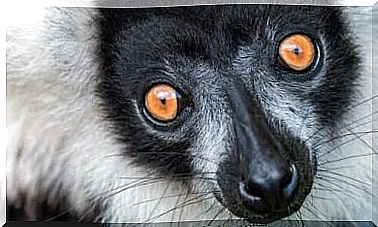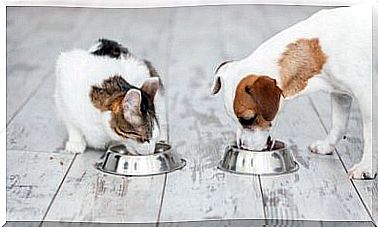Iguana Diet: This Is What It Should Eat

The iguana is a reptile belonging to the order of the Squamata , animals characterized by having the upper jaw fused with the skull. Snakes, chameleons and other lizards also belong to this group. As these animals are increasingly adopted as pets, it is good to know what they eat. So today we will talk about the iguana diet
The distribution of the iguana is mainly concentrated in the area of central and south America, from Mexico to Brazil. However, specimens are also found in Florida, albeit as an invasive species.
Unlike the vast majority of reptiles, the iguana is a herbivorous, specifically leafy animal. In captivity, the iguana’s diet is very deficient, so much so that today the perfect diet for this animal is still unknown.
The diet of the iguana in nature
The iguanas that live freely in their natural habitat feed mainly on leaves taken from the trees on which they live. These are their main source of fiber, protein and calcium. Three indispensable compounds in an iguana’s diet.

Another very popular food for this reptile are flowers, which represent almost 25% of the food ingested every day by an iguana. Those who live in captivity expand their diet with fruit.
However, this food is not very common among free-range specimens, since it represents just 3% of their diet. This is also because it is a food that is difficult for them to find in nature.
What to feed an iguana in captivity
In order for the iguana to maintain good health when forced to live in a terrarium, attention must be paid to several factors. First, they have to eat every day. The leftover remains must be collected in the evening and the container washed with hot water. Their diet must consist almost entirely of vegetables.
Another thing to know is the calcium-phosphorus ratio present in the diet, which must report a value equal to or greater than 2: 1. Below, we report a list of fruits and vegetables, ordered starting from the most recommended, that must be part of the diet of an iguana.

Here is the list of fruits and vegetables most liked by an iguana.
- Turnip greens
- Chinese cabbage
- Cabbage (the outer leaves)
- Coriander
- Kohlrabi
- Mustard (the sprouts)
- Dandelions
- Endive
- Broccoli (the leaves)
- Watercress
- Chard
- Cauliflower leaves
- Parsley
- Beetroot leaves
- Papaya
- Oranges
- Dried figs
- Prickly pears
Fruits and vegetables with an acceptable calcium-phosphorus ratio:
- Avocado
- Garlic
- Celery (leaves)
- Caco
- Strawberry
- Mandarin
- Grape
- Raw leek
Fruits and vegetables to eat only sporadically:
- Apricot
- Zuchini
- Cherry
- Cherimoya
- Date
- Spinach
- Soybean leaf
- Green beans
- Cucumber
- Banana
- Watermelon
- Melon
- Carrot
- Mango
Other factors to consider
In addition to food, the iguana must always have a container with clean water. The water must be changed every day because, like other reptiles, the iguana tends and defecates in it.
The meal should always be served washed and cut into small pieces, to prevent the animal from hurting its mouth. Likewise, the iguana’s diet can include iguanas food.
It is also important to keep the terrarium at an average temperature around 30 ° C, with areas at colder temperatures in which the reptile can thermoregulate. Another important aspect is the amount of sunlight the iguana can take.
During the summer the animal can be left in the sun so that it absorbs the light directly and not through the glass of the terrarium. If you let it out, make sure it always has shaded areas and a container full of water.
During the winter, on the other hand, the iguana needs ultraviolet rays which you can get from a lamp with a wavelength of 290-310 nanometers. If not exposed to these rays, the iguana will not be able to synthesize vitamin D3 and will eventually accumulate calcium. A problem that could even lead to her death.









